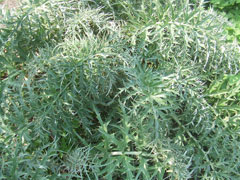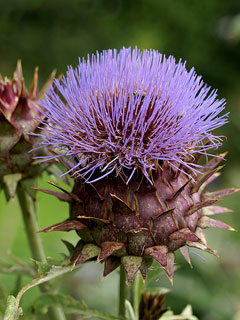 |
|
|
 |
| http://commons.wikimedia.org/wiki/File:Cynara_cardunculus_(Kalmthout).jpg |
Translate this page:
Summary
Cardoon (Cynara cardunculus) is closely related to the globe artichoke but is grown primarily for its stalks rather than flower buds. While globe artichokes are popular in delicate dishes, cardoons are commonly used in hearty stews and gratin. Cardoons are more drought-tolerant and better suited for drier conditions. In contrast, globe artichokes prefer a moist environment during their growing season.
Harvesting: Cardoon stalks are harvested in late summer to autumn, while Globe Artichokes are harvested in late spring to summer.
Physical Characteristics

 Cynara cardunculus is a PERENNIAL growing to 2 m (6ft) by 1 m (3ft 3in) at a medium rate.
Cynara cardunculus is a PERENNIAL growing to 2 m (6ft) by 1 m (3ft 3in) at a medium rate.
See above for USDA hardiness. It is hardy to UK zone 6 and is not frost tender. It is in flower from August to September, and the seeds ripen from September to October. The species is hermaphrodite (has both male and female organs) and is pollinated by Bees, Lepidoptera (Moths & Butterflies). The plant is self-fertile.
It is noted for attracting wildlife.
Suitable for: light (sandy), medium (loamy) and heavy (clay) soils and can grow in heavy clay and nutritionally poor soils. Suitable pH: mildly acid, neutral and basic (mildly alkaline) soils and can grow in saline soils.
It cannot grow in the shade. It prefers dry or moist soil and can tolerate drought. The plant can tolerates strong winds but not maritime exposure.
UK Hardiness Map
US Hardiness Map
Synonyms
Plant Habitats
Woodland Garden Sunny Edge; Cultivated Beds;
Edible Uses
Edible Parts: Flowers Leaves Root Stem
Edible Uses: Curdling agent
Flower buds - raw or cooked[33, 105]. A globe artichoke substitute[183]. The flower buds are a bit smaller than the globe artichoke and so are even more fiddly to use[K]. The buds are harvested just before the flowers open, they are then usually boiled before being eaten. Only the base of each bract is eaten, plus the 'heart' or base that the petals grow from [K]. The flavour is mild and pleasant and is felt by some people to be more delicate than the globe artichoke[K]. Stems - cooked and used as a celery substitute[2, 27, 33, 46, 61]. It is best to earth up the stems as they grow in order to blanch them and reduce their bitterness[4], these blanched stems can then be eaten cooked or in salads[105, 132, 183]. In Italy raw strips of the stems are dipped into olive oil[183]. We find these stems to be too bitter when eaten raw[K]. Young leaves - raw or cooked. Eaten as a salad by the ancient Romans[183]. Rather bitter[K]. Root - cooked like parsnips[27, 105, 183]. Tender, thick and fleshy, with an agreeable flavour[183]. The dried flowers are a rennet substitute, used for curdling plant milks[105, 183].
References More on Edible Uses
Medicinal Uses
Plants For A Future can not take any responsibility for any adverse effects from the use of plants. Always seek advice from a professional before using a plant medicinally.
Anticholesterolemic Cholagogue Digestive Diuretic
The cardoon has become important as a medicinal herb in recent years following the discovery of cynarin. This bitter-tasting compound, which is found in the leaves, improves liver and gall bladder function, stimulates the secretion of digestive juices, especially bile, and lowers blood cholesterol levels[238, 254]. The leaves are anticholesterolemic, antirheumatic, cholagogue, digestive, diuretic, hypoglycaemic and lithontripic[7, 21, 165]. They are used internally in the treatment of chronic liver and gall bladder diseases, jaundice, hepatitis, arteriosclerosis and the early stages of late-onset diabetes[238, 254]. The leaves are best harvested just before the plant flowers, and can be used fresh or dried[238].
References More on Medicinal Uses
The Bookshop: Edible Plant Books
Our Latest books on Perennial Plants For Food Forests and Permaculture Gardens in paperback or digital formats.

Edible Tropical Plants
Food Forest Plants for Hotter Conditions: 250+ Plants For Tropical Food Forests & Permaculture Gardens.
More

Edible Temperate Plants
Plants for Your Food Forest: 500 Plants for Temperate Food Forests & Permaculture Gardens.
More

More Books
PFAF have eight books available in paperback and digital formats. Browse the shop for more information.
Shop Now
Other Uses
Dye
Agroforestry uses:
They can be used as a hedge or border plant, and the dense foliage can provide a habitat for beneficial insects.
The plant is said to yield a good yellow dye[4], though the report does not say which part of the plant is used. 1. Nectary - Flowers rich in nectar and pollen:
Yes – Both Cardoon and Globe Artichoke produce large, vibrant flowers that are rich in nectar and pollen, attracting various pollinators like bees and butterflies.
2. Wildlife - Food (Fruit, Seeds, Leaf litter, Shelter, Nesting, Roosting):
Yes – The edible parts of these plants (flower buds, leaves, and stems) provide food for humans and some wildlife. The dense foliage can offer some shelter, but they are not typically used for nesting or roosting.
3. Invertebrate Shelter (Overwintering sites, Leaf litter, Groundcover):
Yes – The plants can create a habitat for invertebrates, particularly in leaf litter. Their growth habit can provide ground cover, offering some protection and habitat for various species.
4. Pest Confuser (Smell):
No – There is no significant evidence that Cardoon or Globe Artichoke serves as a pest confuser through smell.
Special Uses
Carbon Farming Food Forest
References More on Other Uses
Cultivation details
Industrial Crop: Biomass Management: Hay Management: Standard Staple Crop: Oil
Prefers a light warm soil and an open position in full sun[37, 200]. For best results, this plant requires plenty of moisture in the growing season and a good rich soil[16, 27, 33, 37], though another report says that it is drought tolerant once established[190]. Plants grew very well with us in the hot and very dry summer of 1995, though they were looking very tatty by September[K]. Tolerates most soils including heavy clays of both acid and alkaline nature, especially when grown in heavier or more spartan soils[200]. Plants are reasonably wind resistant[200, K]. This species is hardy to about -10°c[187]. Plants are more likely to require protection from winter cold when they are grown in a heavy soil[190]. Wet winters can do more harm than cold ones[K]. At one time the cardoon was often grown for its edible stems but it has now fallen into virtual disuse[132]. There are some named varieties[183]. It is a very ornamental foliage plant and makes a very attractive feature in the garden. The leaves are long lasting in water and are often used in flower arrangements[233]. Recent taxonomic revisions (1999) have seen the globe artichoke being merged into this species. However, since from the gardener's point of view it is quite a distinctive plant, we have decided to leave it with its own entry in the database under Cynara scolymus[K]. Plants seem to be immune to the predations of rabbits[233]. In garden design, as well as the above-ground architecture of a plant, root structure considerations help in choosing plants that work together for their optimal soil requirements including nutrients and water. The root pattern is fleshy. Thick or swollen - fibrous or tap root [2-1]. Cardoon and Globe Artichoke have moderate growth rates, taking about 2-3 years to establish fully and produce significant yields. Cardoon stalks are typically harvested in late summer to autumn, while Globe Artichokes are harvested in late spring to summer.
Both plants flower in late summer to early autumn
Carbon Farming
-
Industrial Crop: Biomass
Three broad categories: bamboos, resprouting woody plants, and giant grasses. uses include: protein, materials (paper, building materials, fibers, biochar etc.), chemicals (biobased chemicals), energy - biofuels
-
Management: Hay
Cut to the ground and harvested annually. Non-destructive management systems maintaining the soil organic carbon.
-
Management: Standard
Plants grow to their standard height. Harvest fruit, seeds, or other products. Non-Destructive management systems.
-
Staple Crop: Oil
(0-15 percent protein, 16+ percent oil). Some of these are consumed whole while others are exclusively pressed for oil. Annuals include canola, poppyseed, maize, cottonseed, sunflower, peanut. Perennials include high-oil fruits, seeds, and nuts, such as olive, coconut, avocado, oil palm, shea, pecan, and macadamia. Some perennial oil crops are consumed whole as fruits and nuts, while others are exclusively pressed for oil (and some are used fresh and for oil).
References Carbon Farming Information and Carbon Sequestration Information
Temperature Converter
Type a value in the Celsius field to convert the value to Fahrenheit:
Fahrenheit:
The PFAF Bookshop
Plants For A Future have a number of books available in paperback and digital form. Book titles include Edible Plants, Edible Perennials, Edible Trees,Edible Shrubs, Woodland Gardening, and Temperate Food Forest Plants. Our new book is Food Forest Plants For Hotter Conditions (Tropical and Sub-Tropical).
Shop Now
Plant Propagation
Seed - sow early spring in a greenhouse. Germination is usually quick and good, prick out the seedlings into individual pots as soon as they are large enough to handle and plant them out into their permanent positions during the summer. It would be prudent to give the plants some winter protection in their first year. The seed can also be sown in situ in April. Sow the seed 2cm deep, putting 2 or 3 seeds at each point that you want a plant[1]. Protect the seed from mice[1]. Division of suckers. This is best done in November and the suckers overwintered in a cold frame then planted out in April. Division can also be carried out in March/April with the divisions being planted out straight into their permanent positions, though the plants will be smaller in their first year.
Other Names
If available other names are mentioned here
Artichoke; desert artichoke; European cardoon; globe artichoke; scotch thistle; Scottish thistle; Spanish artichoke; wild artichoke; wild cardoon. Spanish: alcachofa; alcaucil; cardo; cardo de comer. French: artichaut commun; carde; cardon d’Espagne. Russian: artišok ispanskij. Arabic: al harshuff. England and Wales: march-ysgall. Finland: Isoartisokka. Germany: artishocke; gemüseartishocke; gemüse-artishocke; kardone. Italy: carciofo. Netherlands: kardoen. Portugal: alcachofra; cardo. Spain: card; card comestible; card comú; herbacol. Sweden: kardon.
Native Range
EUROPE: Albania, Greece, Croatia, Italy (incl. Sardinia, Sicily, Spain (incl. Baleares), France (s. & Corsica), Portugal, AFRICA: Spain, Canarias, Algeria (north), Libya (northwest), Morocco (north), Tunisia.
Weed Potential
Right plant wrong place. We are currently updating this section.
Please note that a plant may be invasive in one area but may not in your area so it's worth checking.
This plant can be weedy or invasive. Native to southern Europe and North Africa, it has been widely introduced and is recognised as invasive in parts of Australia, the USA, Chile and Argentina. In California, it is categorized as a Most Invasive Wildland Pest Plant [1d].
Conservation Status
IUCN Red List of Threatened Plants Status : This taxon has not yet been assessed.

Growth: S = slow M = medium F = fast. Soil: L = light (sandy) M = medium H = heavy (clay). pH: A = acid N = neutral B = basic (alkaline). Shade: F = full shade S = semi-shade N = no shade. Moisture: D = dry M = Moist We = wet Wa = water.
Now available:
Food Forest Plants for Mediterranean Conditions
350+ Perennial Plants For Mediterranean and Drier Food Forests and Permaculture Gardens.
[Paperback and eBook]
This is the third in Plants For A Future's series of plant guides for food forests tailored to
specific climate zones. Following volumes on temperate and tropical ecosystems, this book focuses
on species suited to Mediterranean conditions—regions with hot, dry summers and cool, wet winters,
often facing the added challenge of climate change.
Read More
Expert comment
Author
L.
Botanical References
50200
Links / References
For a list of references used on this page please go here
Readers comment